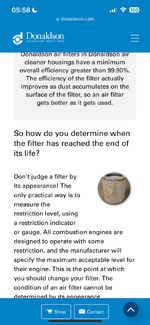I juggle a combination of what the OEM recommends, the type of oil I’m using and oil analysis.
Currently I do 15k km changes on my diesel truck, 10k change on the wife’s Honda and 100 hour changes on the boat. I do oil samples to keep an eye on things.
After a career in the oilfield I’m so used to doing samples and to many times they’ve alerted me to new problems. As a company we do 500 hour changes across all of our engines with mineral oil and I haven’t yet seen an oil related failure. I’ve got one cat with 84,000 hours on it and we rebuild the 60 series detroits at 60k hours.
To many of you are guessing on your change frequency based on something you’ve decided to believe or living in the past where engines and specifically oil were less refined and needed to be changed every 3k miles. Heck, how many said when the oil looks “dirty” WTF is that supposed to mean?
Modern engines and modern oils have pushed the limit so far your throwing money away and not doing the engine any good changing the oil prematurely. There’s a fairly solid literature on thousands of samples through blackstone labs where they used two specific engines across all the samples for those two engines the lab had processed. They compared ppm of wear materials against oil change frequency and made a pretty good case that wear goes up with fresh oil, down through the it’s service life then up again as the additive pack is worn out. Or in other words, there is no indication that wear is minimised with fresh oil, in fact it could be the opposite.
To those of you who think your doing your vehicle a favour by changing air filters frequently, your wrong and doing more harm then good. You should do a little research into air filters and barrier filtration. 90% of the particles an air filter passes are in the first 10% of its life. They’re the least effective when they’re new and they aren’t “bad” until they’re clogging enough to exceed the engines maximum restriction. Every time you disturb an air filter you’re allowing dust into the intake. If you want to do the best you can, put a restriction gauge on the intake and change the filter when it tells you to. Don’t touch or disturb it in between and you’ll be amazed how dirty it will be before it’s actually creating restriction. Air filters are supposed to look dirty, Donaldson filtration calls it the protective dust shield.
I was first exposed to this by Donaldson 10-15 years ago. At the time I changed filters when they looked dirty. I also had hundreds of oil samples with double digit silicon in them. I read Donaldson literature, went down many rabbit holes to verify the ideas they were expressing and eventually I started following it. I’ve now got hundreds more samples with 3-4 ppm silicon in them and haven’t seen a sample since with double digit numbers. My personal vehicles wear restriction gauges and filters don’t get changed until they need it.
Donaldson has some great info on this subject but here is a very small primer
Donaldson air filters in Donaldson air cleaner housings have a 99.95+% minimum overall efficiency. The efficiency of the filter actually improves as dust loads up on the surface of the filter, so an air filter gets better as it gets used.

www.donaldson.com



